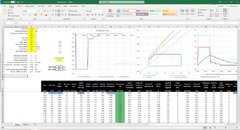Be sure to check your voice to text work! (For those who can't figure it out, he actually said "sinkhole.")At our usual training sync whole,
.....................
What the OP is doing is getting stuck in a transition from one era of tech diving to another and trying to combine both. Here are those eras as I (at least) experienced them.
ERA 1: Preplan the entire dive, write it down, create a couple contingency plans and write them down, too. Follow your plan to the greatest degree possible, switching to a contingency plan if needed and hope it is reasonably close. No computers used--bottom timers only.
ERA 2: OK, I'll take a computer along, in case something bizarre happens, but I will follow the written dive plan and only use the computer for emergencies. I will set the computer for the closest thing I can come to on my written plans and hope it is reasonably close.
ERA 3: Wait, if I follow the written plan and get too far out of whack with the computer it will shut me out? I will tell everyone I am following my written plan, but I will really follow the computer.
ERA 4: Wow! I can actually input the same settings from my desktop program into the computer, so the two should be the same. Now I will admit that I am following the computer, with the written plan (plus contingencies) as a backup.
ERA 5: I will preplan the dive with desktop software and use the same settings on both my computers. No need to have a written plan if I am reasonably close to the desktop plan.





